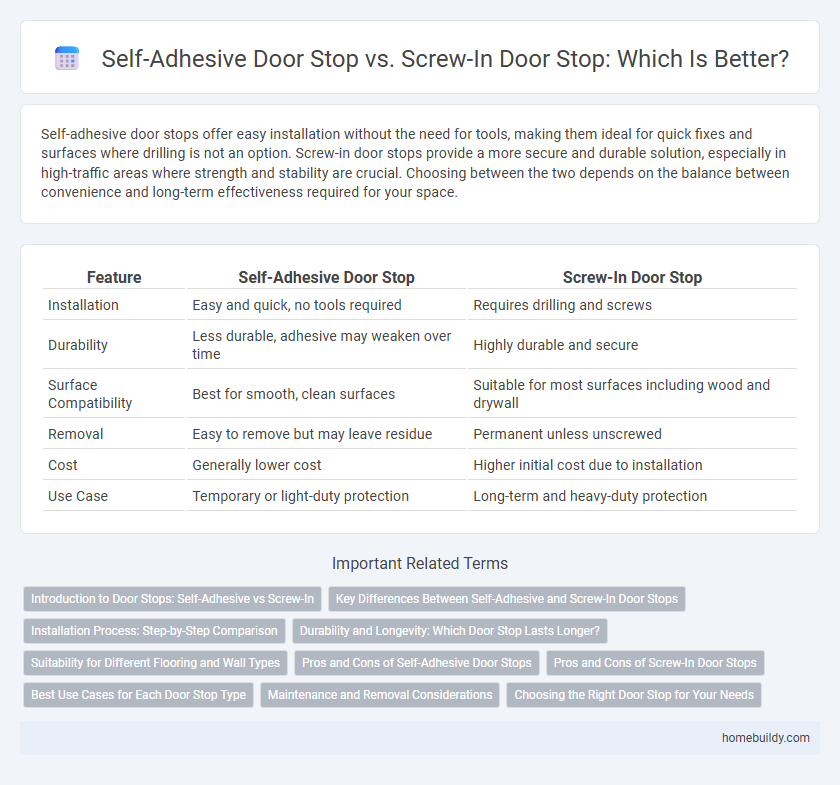Self-adhesive door stops offer easy installation without the need for tools, making them ideal for quick fixes and surfaces where drilling is not an option. Screw-in door stops provide a more secure and durable solution, especially in high-traffic areas where strength and stability are crucial. Choosing between the two depends on the balance between convenience and long-term effectiveness required for your space.
Table of Comparison
| Feature | Self-Adhesive Door Stop | Screw-In Door Stop |
|---|---|---|
| Installation | Easy and quick, no tools required | Requires drilling and screws |
| Durability | Less durable, adhesive may weaken over time | Highly durable and secure |
| Surface Compatibility | Best for smooth, clean surfaces | Suitable for most surfaces including wood and drywall |
| Removal | Easy to remove but may leave residue | Permanent unless unscrewed |
| Cost | Generally lower cost | Higher initial cost due to installation |
| Use Case | Temporary or light-duty protection | Long-term and heavy-duty protection |
Introduction to Door Stops: Self-Adhesive vs Screw-In
Self-adhesive door stops offer easy installation without the need for drilling, featuring a strong adhesive backing suitable for smooth surfaces and light to moderate impact resistance. Screw-in door stops provide a more durable and secure option, anchored firmly into walls or floors, making them ideal for heavy-duty use and high-traffic areas. Choosing between self-adhesive and screw-in door stops depends on surface type, usage intensity, and installation preferences.
Key Differences Between Self-Adhesive and Screw-In Door Stops
Self-adhesive door stops offer easy installation without tools, relying on strong adhesive pads to prevent door damage, making them ideal for light to medium use on smooth surfaces. Screw-in door stops require drilling and provide a more secure, durable hold suited for high-traffic areas or heavy doors, often made of metal for enhanced strength. Key differences include installation method, durability, and suitability for different door weights and wall types.
Installation Process: Step-by-Step Comparison
Self-adhesive door stops install quickly by peeling off the backing and firmly pressing the stop onto a clean, dry surface, requiring no tools or wall damage. Screw-in door stops involve drilling pilot holes and securing the stop with screws, ensuring a more durable and stable hold but demanding more time and tools. The choice depends on whether ease and speed or long-term durability and strength are prioritized in the installation process.
Durability and Longevity: Which Door Stop Lasts Longer?
Self-adhesive door stops offer ease of installation but generally have lower durability due to adhesive wear and potential detachment over time, especially in high-traffic areas. Screw-in door stops feature robust metal or heavy-duty plastic construction, providing superior longevity and resistance to impact, making them ideal for long-term use. For environments requiring lasting performance, screw-in door stops typically outlast self-adhesive options by maintaining secure attachment and structural integrity over years.
Suitability for Different Flooring and Wall Types
Self-adhesive door stops offer excellent compatibility with smooth, non-porous surfaces such as tiled or hardwood floors, making them ideal for renters or temporary installations without damaging walls or floors. Screw-in door stops require more robust mounting on solid wood or drywall with studs, providing greater durability and stability but are less suitable for delicate surfaces like wallpapered walls or laminate floors. Choosing between the two depends on flooring and wall material, with self-adhesive models favoring ease and gentleness, while screw-in stops suit permanent, heavy-use environments.
Pros and Cons of Self-Adhesive Door Stops
Self-adhesive door stops offer easy installation without drilling, making them ideal for renters or temporary setups, but they may lack the durability and holding strength of screw-in models, especially on rough or porous surfaces. They are less likely to damage walls or doors, preserving the paint and finish, yet their adhesive can weaken over time due to temperature changes or moisture exposure. Ideal for light-duty use, self-adhesive door stops require periodic inspection to ensure they remain securely attached.
Pros and Cons of Screw-In Door Stops
Screw-in door stops provide a secure and durable solution by firmly anchoring into the door or wall, making them ideal for heavy doors and high-traffic areas. They offer greater stability compared to self-adhesive door stops, which can lose adhesion over time, especially on textured or uneven surfaces. However, screw-in door stops require tools and may cause permanent damage to mounting surfaces, limiting their suitability for renters or those seeking non-invasive options.
Best Use Cases for Each Door Stop Type
Self-adhesive door stops are ideal for rental properties and temporary installations where wall damage must be minimized, offering easy application on smooth surfaces without tools. Screw-in door stops provide superior durability and stability, making them the best choice for high-traffic areas or doors that deliver stronger impact forces. Selecting between these types depends on longevity requirements, surface compatibility, and installation permanence.
Maintenance and Removal Considerations
Self-adhesive door stops offer easy installation with minimal tools and residue-free removal, ideal for renters or temporary setups requiring low maintenance. Screw-in door stops provide durable, long-term protection but may cause wall damage upon removal, necessitating patching and repainting. Maintenance for screw-in models involves periodic tightening, while self-adhesive versions typically require replacement if adhesion weakens over time.
Choosing the Right Door Stop for Your Needs
Self-adhesive door stops offer quick installation and minimal wall damage, ideal for renters or temporary setups, while screw-in door stops provide stronger durability and stability suited for heavy doors or frequent use. Consider door weight, wall material, and long-term usage when choosing between these types. Selecting the appropriate door stop enhances protection for doors, walls, and nearby furniture.
Self-Adhesive Door Stop vs Screw-In Door Stop Infographic

 homebuildy.com
homebuildy.com